
At a recent staff meeting I attended through the Zoom web conferencing platform, we discussed various staff matters. A colleague brought up a situation where he advised about the need for wheelchair accessibility. There is an ADA Factsheet on Food Service: Accommodating Diners with Disabilities.
As stated under Room to Move:
Path of travel: Check out the path of travel around self-serve stations, ordering and pick-up counters, and seating areas. Make sure there is enough clear space for people using wheelchairs, other mobility aids, or service animals, especially when chairs are pulled out and occupied.

Seating: Dining areas should include some accessible seating for wheelchair and scooter users dispersed throughout the available seating areas.
Heading
I immediately made a connection with the Colorado Governor Jared Polis’s recent mask and social distancing mandate. The path of travel ensures that there is enough clear space for people using wheelchairs, other mobility aids, or service animals. This path of travel recommendation allows restaurants to meet the 6 feet social distancing recommendation. With regard to face masks, the Southeast ADA Center developed recommendations in their The ADA and Face Mask Policies.
This connection between the ADA guidelines for path of travel within restaurants made me reflect on other ways that the ADA has made a difference for all. Such little differences we take for granted include the following:
- Curb cuts or sidewalk ramps that was originally intended for people in wheelchairs but now used by all;
- Automatic door openers are becoming the standard in all places;
- Low-floor buses with ramps or that lower themselves when picking up passengers are becoming more common everywhere;
- Cabinets with pull-out shelves, kitchen counters at several heights are becoming popular options everywhere;
- Captioning feature, while originally intended for deaf people are now being used by more people who are not deaf themselves; and
- Design of handles and utensils are becoming more universal and easier to use.
Heading
Further, Deaf people have also contributed to greater accessibility for all by providing the impetus for the ADA bill becoming our civil rights law. The ADA bill, as brought forward by Senator Tom Harkin (D) in 1988 was passed in the U.S. Senate in 1988 by a wide margin of 76 to 8. This impetus could have been sparked by the "Deaf President Now" (DPN) protests that erupted at Gallaudet University in March 1988. Students at Gallaudet University had requested the Board of Trustees to appoint the first Deaf President in the University’s 124 years of existence. The Board ignored the students' request. As a result, a week-long protest over the selection of the University’s 7th hearing President erupted. The Deaf President Now protest, renamed the Deaf President Now Movement, had a larger impact on our whole society by making people more reflective and aware of the abilities of all people with disabilities.
DPN provided the momentum that allowed the ADA to become the law of the land. The ADA specifically prohibits discrimination against anyone based on their disability. The ADA was finally signed into Law on July 26, 1990. The ADA became law 26 years after the passage of the Civil Rights Act of 1964, and 17 years after the Rehabilitation Act of 1973. President George H. W. Bush proclaimed while signing the ADA, “Let the shameful walls of exclusion finally come tumbling down.”
Heading
The ADA has made tremendous impact on the lives of people with disabilities, not just the United States but worldwide. The world looked on with envy that the ADA protected people with disabilities from discrimination. In December 2001, Mexico proposed that the General Assembly of the United Nations should start drafting an international convention to protect the rights and dignity of persons with disabilities like the ADA. So the ADA served as a model from which the United Nations Convention on the Rights of Persons with Disabilities (UN CRPD) was developed. On March 30, 2007 the Convention and Optional Protocol opened for signature at UN Headquarters in New York, with a record number of 82 opening signatories.
Unlike the 5 Titles of the ADA, the UN CRPD has 50 Articles which covers quite a comprehensive list of rights of persons with disabilities. In closure, we can say that the ADA has come a long way and has influenced the lives of people with disabilities everywhere!
A little Deaf trivia that you may not know…
The title of this blog: ADA Gain: How the ADA Benefits Everyone was inspired by a popular phrase “Deaf Gain” used within the Deaf community. This is a positive term opposed to the oft used negative medical term “Hearing Loss.” The term "hearing loss" is commonly used by non-Deaf professionals working with Deaf people. As a person who was born Deaf, the term “hearing loss” would not apply to me, especially if I never had any hearing to lose in the first place.
Some of the above information have been referenced to in my previous blogs in Rocky Mountain ADA Center’s Access Granted Blog site:
-
The Evolution of Universal Design: A Win-Win Concept for All published on 01/27/2020
-
How Deaf people influenced the passage of the ADA published on 09/24/2019